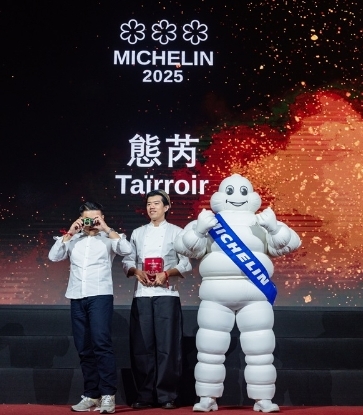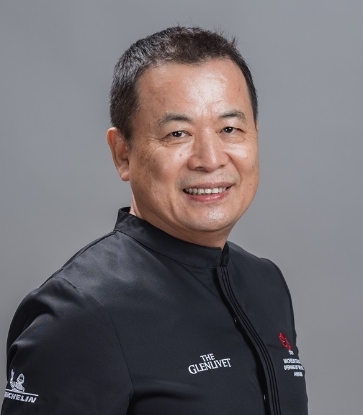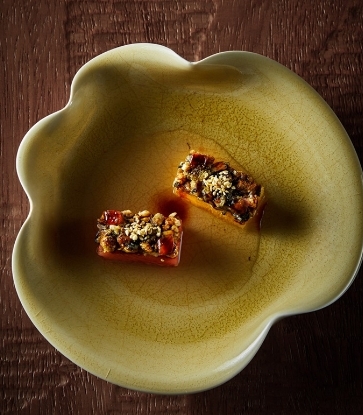Taiwan is a melting pot of cuisines and cultures that constitute its inimitable taste. A crucial ingredient in the recipe? The cuisine and food traditions of the Hakka people.

Historically, Hakkas are Northern Chinese migrants who have resettled in the southern provinces, adapting their ways of living to the restrictions of the environment and differing climates. Hardworking and persistent in the face of adversity, their cooking style reflects the same humility and heartiness. Chef Jackie Chang (pictured right) of MICHELIN-listed Ceo 1950 cites the example of the many hardy, long-lasting dishes in traditional Hakka cuisine, including preserved foods like salted pork, on-the-go snacks such as ban dumplings, as well as dishes that stood up well to multiple re-heatings like dried bamboo soup and pig stomach soup.
Chang’s family hails from Tongluo in the Miaoli County, and his childhood memories are filled with breakfasts of rice mixed with soy sauce and fragrant lard, watching his grandmother and mother grind rice to make flour, and helping to turn over pickles and radishes that were laid out to dry. It was not until he began culinary school in his tertiary years that he started combing through these childhood memories and the food traditions of his family for inspiration. At Ceo 1950, he weaves these Hakka elements into the menu, reinterpreting its traditional flavors for a new audience.
Flavors from Fermentation
Chef Manager Lee Po-she of Bib Gourmand restaurant Niou Jia Juang in Taichung believes that the essence of Hakka cuisine can be found in its sauce fermentation jars. "Hakka people were diligent and thrifty, devising techniques for pickling ingredients that preserved them for a long time,” he says. These ferments used to be stored in earthen jars but are now mostly bottled. Some familiar flavors include pineapple or orange sauce, as well as preserved seasonal vegetables such as pickled green mustard and winter melon, which are used in many Hakka dishes.

Lee (pictured left) is of the third generation of Dongshi Hakka villagers. Founded in 1960, Niou Jia Juang offers beef dishes made from local yellow cattle. Lee and his brother took over the restaurant about 10 years ago, adding more Hakka dishes to the menu to provide customers with more choices. The chef expresses the true nature of Hakka cuisine through his attention to detail, insistence on using high-quality ingredients and skillful cooking techniques.
Unique Hakka Rice Dishes
In addition to pickled foods, another characteristic of Hakka cuisine is its rice dishes such as flat rice noodles, Hakka rice cakes, or ban, which are cakes made from glutinous rice. These cakes were made to be eaten on-the-go, filling enough to satiate and provide energy for working class Hakka. Different varieties were also eaten on special occasions, explains Lee. Xin ding ban were gifted to friends and relatives upon the birth of a boy, while ai ban was eaten during the Qingming Festival and there are also various sweet cakes made with local ingredients such as roselle and red beans,

Another classic rice dish in Hakka cuisine is ciba, a sweet snack of steamed glutinous rice balls rolled in peanut powder and sugar. At Ceo 1950, chef Chang was inspired by this ubiquitous snack to create a dessert course of Sichuan Green Pepper/Ciba. The glutinous rice balls are made the traditional way, then dipped in roasted peanut crumble and topped with 67% dark chocolate sauce and Japanese satsuma (a variety of orange) pulp. To finish, the dish is garnished with green Sichuan peppercorn oil and peanut sugar brittle, which adds a contrasting texture and elevates the presentation.
Exploring Hakka Flavors in Taiwan
The Hakka diaspora is spread widely over Taiwan, and Hakka villages all over the region express the cuisine differently, having adapted to different weather and geographical conditions and the availability of local produce.
For example, as Niou Jia Juang’s chef Lee explains, while pickled vegetables are ubiquitous in Hakka cuisine, in Dongshi, local Lishan cabbages might be used; while in Meinong, local radishes would be preferred. Chef Chang concurs, noting that the Hakka people living in the mountainous area of the Miaoli County often use the leaves of shell ginger or wild ginger plants to wrap their food, like rice cakes or vegetable buns, for steaming. On the other hand, coastal inhabitants, such as his mother-in-law, favor the use of the hibiscus leaves instead.

The best way of understanding Hakka cuisine in Taiwan is to taste its most classic dishes that are referred to as the si wen si chao, which consists of four dishes braised low and slow, and four stir-fried dishes that are flash cooked under high heat. The four braised dishes are braised pork belly with pickled vegetables, braised pork, braised pork ribs with radish, and stewed dried bamboo shoots in rich soup; while the four stir-fries include stir-fried Hakka pork, stir-fried pork intestines with shredded ginger, duck blood stir-fried with chives, and pig lungs stir-fried with black fungus and pineapple.
Both chefs Chang and Lee have a common favorite among the eight: the Hakka pork stir-fry. To them, this dish is the most representative of the cuisine and its people. Made traditionally from pork used in ritual offerings, the meat is stir-fried with preserved dried squid and green onions. With most Taiwanese Hakkas living in the mountainous regions, seafood is hard to come by and are mostly dried to preserve them for longer; diligent and thrifty, Hakkas would up-cycle the ingredients from religious offerings and altar tables in their stir-fries (Banner image: A typical stir-fry from Niou Jia Juang), often transforming any leftovers into new dishes the next day by stir-frying it again with fresh greens like celery.
(Right Image: Pork Belly / Squid / Scallion from Ceo 1950)
Every Hakka family has its own version of the Hakka stir-fry, adds Chang, reminiscing about his grandmother’s technique of sautéing the three-layered meat first, then adding green onions and dried squid before finishing with rice wine and soy sauce, and simmering it until dry. Any leftovers would then be refreshed with green onions and rice wine the next day. "This dish only tastes its best on the third day, but by then, it’s usually gone,” he laughs.
His own rendition on the Ceo 1950 menu features three-layered pork belly cooked low and slow in olive oil. The pork skin is brushed with white vinegar and air-dried, a process repeated four times before the pork is then fried and roasted. Strong-tasting and naturally funky, dried squid is a key element of the original dish that is difficult to incorporate in any modern interpretation. But Chang has creatively introduced it in a seasoning with green onions and soy sauce for fresh squid, which is then flash-cooked and served with fried yuba, garlic sprouts, celery, and green onion purée.

In addition to the classic Hakka stir-fry, chef Lee highly recommends two other Hakka dishes that encapsulate the characteristic fermented flavors of Hakka cuisine: braised pork belly steamed atop salty preserved vegetables, as well as chicken soup with preserved vegetables — his version at Niou Jia Juang is stewed with preserved vegetables that are 10 to 15 years old, imparting a mellow, savory flavor to the soup.
Chang’s creative interpretation of another classic Hakka dish of stir-fried pig intestines with shredded ginger and white vinegar replaces the main protein with a similarly textured fungus stir-fried in a soy sauce infused with pomelo juice and yellow mustard for added acidity.
In another bold departure from tradition, Chang pairs Hakka sweet-and-sour orange sauce with seafood, a protein that is seldom used in Hakka cuisine. “But really, orange sauce goes with anything,” says the chef, who believes that there are wider applications for the sauce beyond the usual chicken and pork. At Ceo 1950, he created a dish of mackerel marinated in Japanese yuzu juice, served with daikon and potatoes seasoned with salt, pepper, and thyme. The dish is then dressed with a creamy vegetable jus and Hakka orange sauce elevated with a touch of pomelo fragrance.
From past to present, Hakka cuisine in Taiwan has evolved and become intricately intertwined with local customs and ingredients. Its future holds even more promise and limitless possibilities for innovation.
All photos are courtesy of the restaurants.























